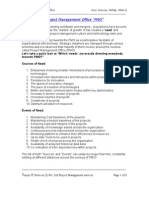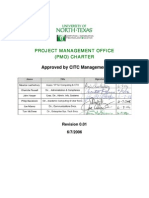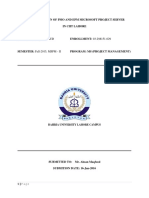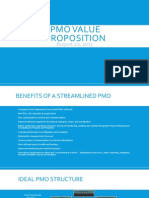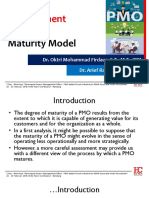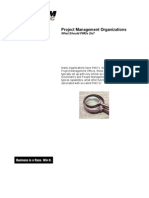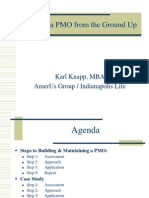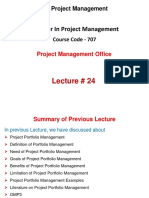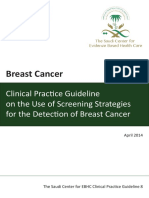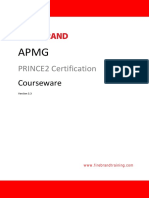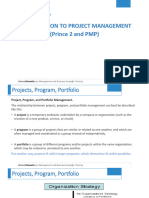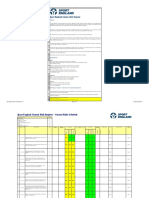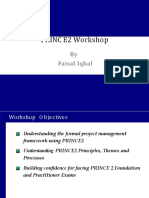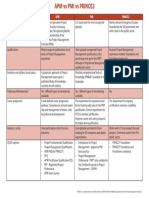Project Management Office (PMO)
A Project Management Office (PMO) is a group or department within a business, agency or enterprise that defines and maintains standards for project management within the organization. The primary goal of a PMO is to achieve benefits from standardizing and following project management policies, processes and methods. Over time, a PMO generally will become the source for guidance, documentation, and metrics related to the practices involved in managing and implementing projects within the organization. A PMO may also get involved in project-related tasks and follow up on project activities through completion. The office may report on project activities, problems and requirements to executive management as a strategic tool in keeping implementers and decision makers moving toward consistent, business- or mission-focused goals and objectives. A PMO generally bases its project management principles, practices and processes on some kind of industry standard methodology such as PMBOK (Project Management Body of Knowledge) or PRINCE2 (Project in Controlled Environments). Such approaches are consistent with the requirements related to ISO9000 and to government regulatory requirements such as the US Sarbanes-Oxley (SOX) program. How a project management office (PMO) is designed and staffed for maximum effectiveness depends on a variety of organizational factors, including targeted goals, traditional strengths and cultural imperatives. There are three basic
�organizational styles for a project management office. 1. The project repository: This model occurs most often in organizations that empower distributed, business-centric project ownership, or enterprises with weak central governance. The project office simply serves as a source of information on project methodology and standards. Project managers continue to report to, and are funded by, their respective business areas. 2. The project coach model: This model assumes a willingness to share some project management practices across business functions and uses the project office to coordinate the communication. Best practices are documented and shared and project performance is monitored actively. The PMO in this model is a permanent structure with staff and has some supervisory responsibility for all projects. The enterprise project management office: This model also assumes a governance process that involves the project office in all projects, regardless of size, allowing it to assess scope, allocate resources and verify time, budget, risk and impact assumptions before the project is undertaken. Funding is generally a combination of direct, budgeted allocation for baseline services and a fee-for-service charge for others.
Responsibilities of a project management office (PMO)
by a dm in on J an u ar y 9, 20 11
In most organisations the PMO has five main responsibilities: Set standards for how projects are run The PMO builds up a common set of practices, principles and templates for managing projects. Standardisation means project managers can move more easily between different projects and
�new project managers get up to speed faster. Creating project management templates means standard components can be reused which saves time and money as they are not created for each project fresh.
Ensure project management standards are followed While the PMO sets project management standards, it also must ensure they are followed by performing regular assessments of projects. This process can feedback into the standards definition. Gathering of project data and production of information for management review The PMO will track the status of all projects in the organisation based on updates from the project managers. They will standardise the way this information is compiled and reported to management. The normal way to present the information is using project dashboards which provide a clear way to keep track of the status of projects. Source of guidance and advice for project managers Most PMOs develop into a centre of excellence for project management and can provide guidance and coaching to novice project managers or new project managers who need to understand how the organisation runs projects. In many organisations we work with, the people running projects are not
�always formally trained project managers and the PMO plays a key role in assisting this group.
Managing and facilitating the portfolio management process For organisations that have implemented a project portfolio management approach (PPM), the PMO manages and facilitates this process. This can include: Capturing project requests and ensuring each request has sufficient information to assess the project. Keeping an up-to-date repository of projects underway and requests pending review. Implementing scoring and prioritisation models to help assess which requests should be approved. Managing a resource capacity plan or resource forecast to help understand resource availability for projects.
The 3 Different Types of Project Management Offices
By John Reiling There are 3 basic types of Project Management Office (PMO) organisations, varying in the degree of control and influence they have on projects within the organisation. You will need to determine which type you need to establish in order to have an effective project office. The 3 types of PMOs include:
�1. Supportive PMO
The Supportive PMO generally provides support in the form of on-demand expertise, templates, best practices, access to information and expertise on other projects, and the like. This can work in an organisation where projects are done successfully in a loosely controlled manner and where additional control is deemed unnecessary. Also, if the objective is to have a sort of "clearing-house" of project management information across the enterprise to be used freely by project managers, then the Supportive PMO is the right type.
2. Controlling PMO
In organisations where there is a desire to "rein in" the activities, processes, procedures, documentation, and more - a controlling PMO can accomplish that. Not only does the organisation provide support, but it also requires that the support be used. Requirements might include adoption of specific methodologies, templates, forms, conformance to governance, and application of other PMO controlled sets of rules. In addition, project offices might need to pass regular reviews by the controlling PMO, and this may represent a risk factor on the project. This works if a) there is a clear case that compliance with project management organisation offerings will bring improvements in the organisation and how it executes on projects, and b) the PMO has sufficient executive support to stand behind the controls the PMO puts in place.
3. Directive PMO
This type goes beyond control and actually "takes over" the projects by providing the project management experience and resources to manage the project. As organisations undertake projects, professional project managers from the PMO are assigned to the projects. This injects a great deal of professionalism into the projects, and, since each of the project managers originates and reports back to the directive PMO, it guarantees a high level of consistency of practice across all projects. This is effective in larger organisations that often matrix out support in various areas, and where this setup would fit the culture. The best type is very specific to the organisation, culture, and history of what works and what does not. But the objectives are - more or less - to:
� Implement a common methodology Standardise terminology Introduce effective processes repeatable project management
Provide common supporting tools Ultimately, the objective is to improve levels of project success within the organisation Being aware of these types can help you and your organisation more easily accomplish this.



